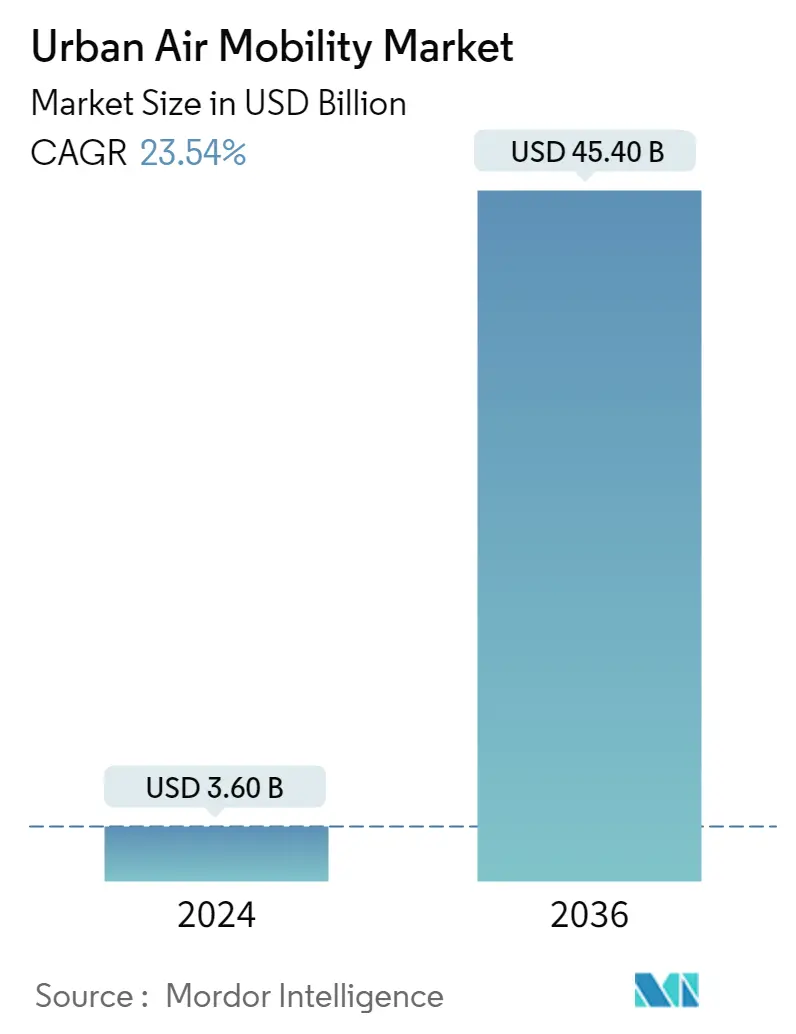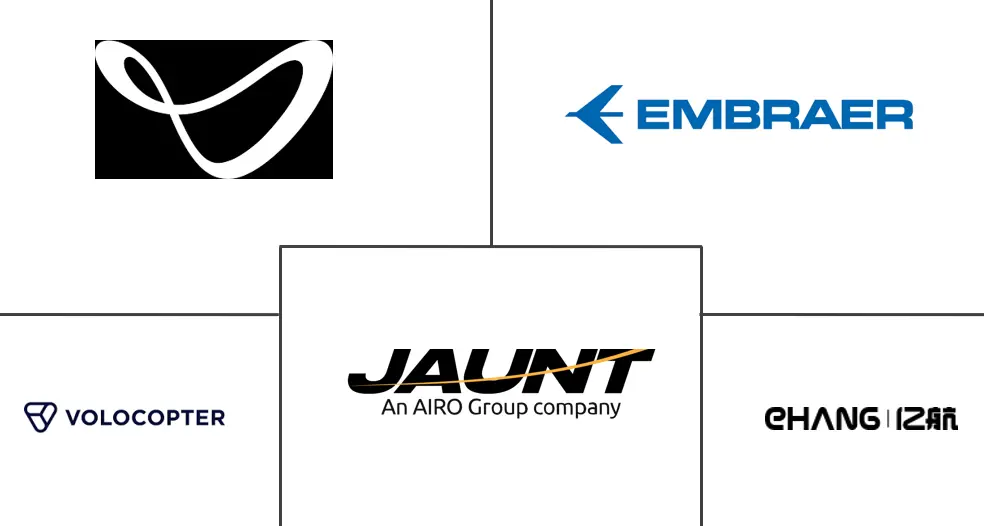Market Size of Urban Air Mobility Industry

| Study Period | 2019 - 2036 |
| Market Size (2024) | USD 3.60 Billion |
| Market Size (2036) | USD 45.40 Billion |
| CAGR (2024 - 2036) | 23.54 % |
| Fastest Growing Market | Asia-Pacific |
| Largest Market | North America |
Major Players
*Disclaimer: Major Players sorted in no particular order |
Urban Air Mobility (UAM) Market Analysis
The Urban Air Mobility Market size is estimated at USD 3.60 billion in 2024, and is expected to reach USD 45.40 billion by 2036, growing at a CAGR of 23.54% during the forecast period (2024-2036).
The COVID-19 pandemic has had an unprecedented impact on all industries globally. The aviation sector has been severely affected by the pandemic. Since most of the major urban air mobility (UAM) sector players are directly or indirectly related to the aviation sector, the pandemic has had a ripple effect on the UAM sector. Before the COVID-19 outbreak, the UAM sector, which was still in its formative stages, witnessed healthy growth with a healthy pace of development and high investments. However, the COVID-19 pandemic caused delays and affected project launches scheduled in the short term in 2020. Nevertheless, the delays were witnessed only for the short term and did not jeopardize the general deployment of UAM.
The growing traffic congestion issues, especially in larger cities, are propelling the need for faster modes of intracity transportation. In this regard, the urban air mobility concept is gaining importance. There are many R&D investments in the urban air mobility industry, with many start-ups and aerospace players eyeing this market as one with high growth potential. Therefore, such factors are expected to drive the market's growth focus during the forecast period.
Urban Air Mobility (UAM) Industry Segmentation
The urban air mobility (UAM) market is an aviation industry term for on-demand and automated passenger or cargo-carrying air transportation services around cities and urban areas.
The UAM market is segmented by vehicle type, application, and geography. By vehicle type, the market is segmented into piloted and autonomous. By application, the market is segmented into passenger transport and freighter. The report also covers the market sizes and forecasts for the UAM market across major regions. The market sizing and forecasts have been done for each segment based on value (USD billion).
The scope of the study is limited to electric vertical takeoff and landing (eVTOL) systems and does not include gas turbine engine-powered helicopters. The report also encompasses both intercity and intracity aspects of the operation of the eVTOLs.
| Vehicle Type | |
| Piloted | |
| Autonomous |
| Application | |
| Passenger Transport | |
| Freighter |
| Geography | |
| North America | |
| Europe | |
| Asia-Pacific | |
| Latin America | |
| Middle-East and Africa |
Urban Air Mobility Market Size Summary
The urban air mobility (UAM) market is poised for significant expansion over the forecast period, driven by increasing traffic congestion in urban areas and the need for faster intracity transportation solutions. Despite the initial setbacks caused by the COVID-19 pandemic, which impacted the aviation sector and delayed some UAM projects, the market has shown resilience and is expected to experience robust growth. The sector is attracting substantial investments from both startups and established aerospace companies, all keen to capitalize on the high growth potential of UAM technologies. The development of autonomous electric vertical take-off and landing (eVTOL) aircraft is a key focus, with companies like Wisk Aero and EHang leading the charge in creating pilotless urban air transport solutions. These advancements promise to enhance efficiency and reduce urban congestion, offering a compelling alternative to traditional ground-based transportation.
The Asia-Pacific region is emerging as a pivotal area for UAM development, with countries such as China, Japan, and South Korea making significant investments in UAM ecosystems. Government initiatives in these countries are facilitating the introduction of advanced aviation vehicles, such as passenger drones and flying cars, which are expected to accelerate market growth. The UAM market remains consolidated, with a few key players like Embraer SA, Volocopter GmbH, and Joby Aero, Inc. holding substantial market shares. These companies are actively pursuing regulatory approvals and partnerships to advance their UAM offerings. As flight testing and regulatory processes progress, the market is anticipated to expand further, with companies poised to enhance their geographical presence and fulfill orders from aerial mobility service providers.
Urban Air Mobility Market Size - Table of Contents
-
1. MARKET DYNAMICS
-
1.1 Market Overview
-
1.2 Market Drivers
-
1.3 Market Restraints
-
1.4 Porter's Five Forces Analysis
-
1.4.1 Bargaining Power of Buyers/Consumers
-
1.4.2 Bargaining Power of Suppliers
-
1.4.3 Threat of New Entrants
-
1.4.4 Threat of Substitute Products
-
1.4.5 Intensity of Competitive Rivalry
-
-
-
2. MARKET SEGMENTATION
-
2.1 Vehicle Type
-
2.1.1 Piloted
-
2.1.2 Autonomous
-
-
2.2 Application
-
2.2.1 Passenger Transport
-
2.2.2 Freighter
-
-
2.3 Geography
-
2.3.1 North America
-
2.3.2 Europe
-
2.3.3 Asia-Pacific
-
2.3.4 Latin America
-
2.3.5 Middle-East and Africa
-
-
Urban Air Mobility Market Size FAQs
How big is the Urban Air Mobility Market?
The Urban Air Mobility Market size is expected to reach USD 3.60 billion in 2024 and grow at a CAGR of 23.54% to reach USD 45.40 billion by 2036.
What is the current Urban Air Mobility Market size?
In 2024, the Urban Air Mobility Market size is expected to reach USD 3.60 billion.

